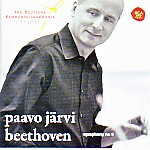No performance of the Ninth with chamber forces has ever done it justice, and good as this is (or at least consistent as this cycle has been), it’s no exception. From questions of balance to issues of dynamic range and sonority, there is basically no problem posed by the work whose solution lies in having fewer performers on hand. Yes, Järvi drives the opening movement excitingly, but listen to how thin the central fugue sounds, how tinny the recapitulation, despite the fact that brass and timpani are playing full out and Järvi’s phrasing and timing are spot-on and very exciting.
The Scherzo’s lighter textures suit the approach much better, particularly given the splendidly tight ensemble, and Järvi happily doesn’t rush through the Adagio as so many “authentic-style” conductors do. A bit more than 13 minutes sounds exactly right here. Järvi also has the sense, in the finale, to hold back at the final choral apotheosis and cut loose with a real prestissimo coda. But the choir still lacks power, and baritone Matthias Goerne sports a painful wobble above mezzo-forte. The other soloists, all light-voiced, are good, but then no one buys a Ninth for the soloists, do they?
Here’s the bottom line: this performance is very much part and parcel of Järvi’s approach. It’s very well played, very intelligently interpreted, and often exciting. But, as so often happens in Beethoven cycles, the same approach doesn’t suit all the symphonies equally. Beethoven’s evolution as an artist has to be met with an equal flexibility of approach coming from his interpreters. The best cycles, in their various ways, understand this and adapt accordingly. Järvi does not, and given the forces at his disposal, perhaps he could not. He does what he can to minimize any disadvantages, but the scale of this performance is still too small to encompass the enormity of Beethoven’s vision.
































